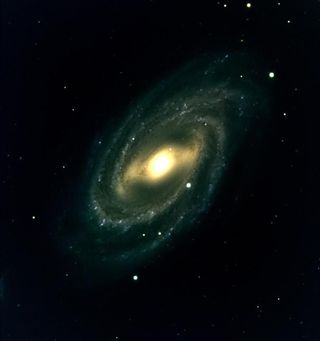1st Photos from New Discovery Channel Telescope Unveiled

A privately funded telescope has taken its first images, capping off a two decades-long quest to construct the facility for research and public engagement.
The Discovery Channel Telescope is an observatory with a 14-foot (4.3-meter) mirror built near Happy Jack, Ariz., by the Lowell Observatory and Discovery Communications, the parent company of television's Discovery Channel. The telescope's opening was marked with a gala on Saturday (July 21) at Lowell Observatory in Flagstaff and featured a keynote speech from Neil Armstrong, the first person ever on the moon.
"The First Light Gala is a historic event in the annals of Lowell Observatory," Jeffrey Hall, director of Lowell Observatory, said in a statement. "It marks completion of our spectacular new research facility, initiation of superb projects that will bring our research to millions through our partnership with Discovery Communications. We are honored to be part of it and grateful to all who have helped make it a reality."
The $53 million Discovery Channel Telescope is the fifth largest telescope in the continental United States, and was paid for without any federal or state funding. The observatory snapped its inaugural pictures — including views of the famous Whirlpool and Sombrero galaxies, as well as the M109 barred spiral galaxy — in May using its 16-million-pixel camera.
"The Discovery Channel Telescope is emblematic of our mission to ignite curiosity and stir the imagination of audiences here and around the globe," said John Hendricks, founder and chairman of Discovery Communications, who, with his wife Maureen, was a major donor to the project. "The telescope represents 'discovery' in both word and deed and we are thrilled to see the amazing places it will take us with breathtaking images and vital new research."
Though the telescope's eyes are now open to the universe, it will undergo a testing phase for about 18 months, with its first scientific data gathering expected to begin in 2013 or 2014. Its location, in the Coconino National Forest about 45 miles (72 kilometers) south-southeast of Flagstaff, is in a dark-sky site, one of the darkest, best places from which to view the night sky in the United States.
The process of planning and building the telescope is due to be featured in a one-hour Discovery Channel documentary set to air in September 2012.
Get the Space.com Newsletter
Breaking space news, the latest updates on rocket launches, skywatching events and more!
Follow SPACE.com on Twitter @Spacedotcom. We're also on Facebook & Google+.
Join our Space Forums to keep talking space on the latest missions, night sky and more! And if you have a news tip, correction or comment, let us know at: community@space.com.

Space.com is the premier source of space exploration, innovation and astronomy news, chronicling (and celebrating) humanity's ongoing expansion across the final frontier. Originally founded in 1999, Space.com is, and always has been, the passion of writers and editors who are space fans and also trained journalists. Our current news team consists of Editor-in-Chief Tariq Malik; Editor Hanneke Weitering, Senior Space Writer Mike Wall; Senior Writer Meghan Bartels; Senior Writer Chelsea Gohd, Senior Writer Tereza Pultarova and Staff Writer Alexander Cox, focusing on e-commerce. Senior Producer Steve Spaleta oversees our space videos, with Diana Whitcroft as our Social Media Editor.
